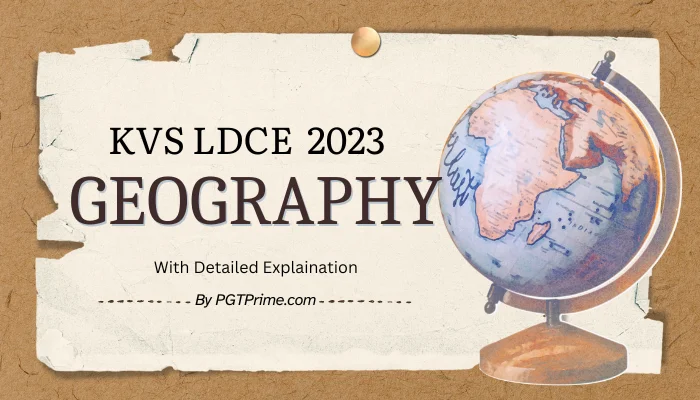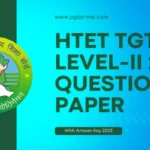👉FROM (Q.21-To-Q.40)
21. Ultra-violet rays are absorbed by which one of the following gas?
- Oxygen
- Carbon dioxide
- Ozone
- Hydrogen
Answer: KVS LDCE Geography Question Paper and Answers pdf 2023
3. Ozone
Ozone (O₃) in the Earth’s stratosphere absorbs the majority of the Sun’s harmful ultraviolet (UV) radiation.
22. Which one of the followings is the range of insolation received on the earth’s surface?
- 10 to 300 Watt/m2
- 70 to 320 Watt/m2
- 170 to 1320 Watt/m2
- 100 to 875 Watt/m2
Answer: KVS LDCE Geography Question Paper and Answers pdf 2023
2. 70 to 320 Watt/m2
Insolation, or incoming solar radiation, varies significantly based on factors such as geographic location, time of year, and atmospheric conditions. This range encompasses the typical values of solar energy received per square meter on the Earth’s surface.
23. Which one of the following percentages of solar radiation is reflected back to space without heating the earth surface or atmosphere?
- 17%
- 27%
- 35%
- 48%
Answer: KVS LDCE Geography Question Paper and Answers pdf 2023
3. 35%
Approximately 35% of the solar radiation that reaches the Earth is reflected back into space by the Earth’s atmosphere, clouds, and surface without being absorbed. This percentage is known as the Earth’s albedo.
24. Which one of the followings is NOT a factor affecting the distribution of temperature on the earth?
- Longitude
- Latitude
- Altitude
- Ocean currents
Answer: KVS LDCE Geography Question Paper and Answers pdf 2023
- Longitude
Longitude does not significantly affect the distribution of temperature on Earth. The primary factors that influence temperature distribution are latitude (distance from the equator), altitude (height above sea level), and ocean currents (which can transport warm or cold water, influencing coastal temperatures).
25. Which one of the following instruments is used to measure atmospheric pressure?
- Thermometer
- Rotameter
- Barometer
- Planimeter
Answer: KVS LDCE Geography Question Paper and Answers pdf 2023
3. Barometer
A barometer is an instrument used to measure atmospheric pressure. It helps in weather forecasting and altitude determination.
26. At which one of the following latitudes, the coriolis force is absent?
- Poles
- 66.5° N and S latitudes
- 23.5° N and S latitudes
- Equator
Answer: KVS LDCE Geography Question Paper and Answers pdf 2023
4. Equator
Coriolis effect, which causes moving objects to be deflected due to Earth’s rotation, is strongest at the poles and decreases to zero at the Equator.
27. Tropical cyclone in Western Australia is known by which one of the followings?
- Hurricanes
- Willy-willies
- Typhoons
- Tornadoes
Answer: KVS LDCE Geography Question Paper and Answers pdf 2023
2. Willy-willies
In the Atlantic and Northeast Pacific, they are called hurricanes; in the Northwest Pacific, they are called typhoons; and in Australia, they are often referred to as willy-willies.
28. Which one of the following types of cloud is formed at the highest altitude?
- Cirrus
- Nimbus
- Stratus
- Cumulus
Answer: KVS LDCE Geography Question Paper and Answers pdf 2023
- Cirrus
Cirrus clouds form at the highest altitudes, typically above 20,000 feet (6,000 meters). They are thin, wispy clouds composed mostly of ice crystals.
29. Which one of the following gases in NOT a greenhouse gas?
- Carbon dioxide
- Chloroflurocarbons
- Oxygen
- Ozone
Answer: KVS LDCE Geography Question Paper and Answers pdf 2023
3. Oxygen
Greenhouse gases, such as carbon dioxide, chlorofluorocarbons (CFCs), and ozone, trap heat in the Earth’s atmosphere, contributing to the greenhouse effect.
30. Over which one of the followings, water depth is the least?
- Continental shelf
- Continental slope
- Deep sea plain
- Oceanic deeps
Answer: KVS LDCE Geography Question Paper and Answers pdf 2023
- Continental shelf
The continental shelf is the gently sloping submerged portion of a continent that extends from the shoreline to a variable distance seaward where water depth is relatively shallow.
31. Which one of the followings is a warm ocean current?
- West Australian current
- Benguala current
- Humboldt current
- Auglhas current
Answer: KVS LDCE Geography Question Paper and Answers pdf 2023
4. Auglhas current
The Agulhas Current is a warm ocean current that flows southward along the east coast of Africa, carrying warm water from the Indian Ocean. The West Australian Current, Benguela Current, and Humboldt Current are all cold ocean currents.
32. Which one of the followings is the largest in number in a grassland ecosystem?
- Producers
- Herbivores
- Carnivores
- Omnivores
Answer: KVS LDCE Geography Question Paper and Answers pdf 2023
- Producers
In a grassland ecosystem, producers, which are primarily grasses and other plants, are the largest in number. They form the base of the food chain and provide energy for herbivores, which in turn are prey for carnivores and omnivores.
33. Which one of the followings is NOT a category of species for the purpose of their conservation?
- Endangered species
- Available species
- Vulnerable species
- Rare species
Answer: KVS LDCE Geography Question Paper and Answers pdf 2023
2. Available species
The recognized categories include endangered species, vulnerable species, and rare species.
34. Which one of the following longitudes is selected as the standard meridian of India?
- 81°30’ E
- 82°00’ E
- 82°30’ E
- 83°00’ E
Answer: KVS LDCE Geography Question Paper and Answers pdf 2023
3. 82°30’ E
This meridian is used as the reference for Indian Standard Time (IST), which is 5 hours and 30 minutes ahead of Coordinated Universal Time (UTC+5:30).
35. Which one of the following lengths shows the length of Great Himalayan range from west to east?
- 2650 km
- 2980 km
- 2500 km
- 1525 km
Answer: KVS LDCE Geography Question Paper and Answers pdf 2023
3. 2500 km
The Great Himalayan range extends approximately 2500 km from west to east. This massive mountain range spans across five countries: India, Nepal, Bhutan, China, and Pakistan.
36. Which one of the followings is the highest peak of Peninsular Plateau?
- Dodabetta
- Vavul Mala
- Makurti
- Anaimudi
Answer: KVS LDCE Geography Question Paper and Answers pdf 2023
4. Anaimudi
Anaimudi, located in the Western Ghats in Kerala, is the highest peak of the Peninsular Plateau, with an elevation of 2,695 meters (8,842 feet) above sea level.
37. Which one of the following rivers joins with Rann of Kuchchh?
- Sabarmati
- Luni
- Mahi
- Betwa
Answer: KVS LDCE Geography Question Paper and Answers pdf 2023
2. Luni
The Luni River, which originates in the Aravalli Range in Rajasthan, flows southwest and eventually dissipates into the Rann of Kutch in Gujarat.
38. Which one of the followings is the largest east flowing Peninsular river?
- Godavari
- Mahanadi
- Kaveri
- Krishna
Answer: KVS LDCE Geography Question Paper and Answers pdf 2023
- Godavari
The Godavari River is the largest east-flowing river in the Peninsular region of India. It originates in the Western Ghats and flows eastwards across the Deccan Plateau to empty into the Bay of Bengal.
39. The annual range of temperature is the highest at which one of the following places?
- Jaisalmer
- Allahabad
- Kolkata
- Guwahati
Answer: KVS LDCE Geography Question Paper and Answers pdf 2023
- Jaisalmer
Jaisalmer, located in the Thar Desert of Rajasthan, experiences extreme temperature variations between summer and winter.
40. Which one of the following dates represents onset of southwest monsoon at Kerala coast?
- 01 June
- 15 June
- 01 July
- 15 May
Answer: KVS LDCE Geography Question Paper and Answers pdf 2023
- 01 June
The onset of the southwest monsoon at the Kerala coast is typically around 01 June.











